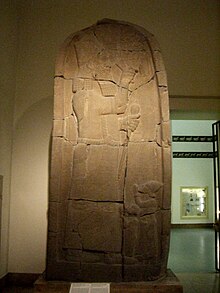Victory stele of Azarhaddon

The victory stele of Asarhaddon , also Zincirli stele, is from around 669 BC. Neo-Assyrian basalt stele from Sam'al ( Turkey ) , 3.18 m high . The stele, which is now in the Vorderasiatisches Museum in Berlin, originally stood as a victory monument near the Syrian-Turkish border. It glorifies the victory of Aššur-aḫḫe-iddinas over the Egyptian pharaoh Taharqa and the city prince of Sidon , Abdi-Milkutti in the year 670 BC. Chr.
The two defeated rulers are shown as kneeling prisoners. A ring was driven through their jaws, to which a line is attached, which Aššur-aḫḫe-iddina is holding in her hand. It is obvious that this is a symbolic representation, since it is known that Taharqa successfully evaded capture. There are symbols of gods and cult images near the head of the Assyrian king . The narrow sides of the stele show the sons and successors Aššur-aḫḫe-iddinas, Aššur-bani-apli in Assyrian and Šamaš-šuma-ukin in Babylonian rulers.
literature
- Orthmann, Winfried : New Assyrian and late Babylonian flat art. In the S. (Ed.): The old Orient . Propylaen Verlag, Berlin 1985 ( Propylaen Art History XVIII), ISBN 3-549-05666-4 .